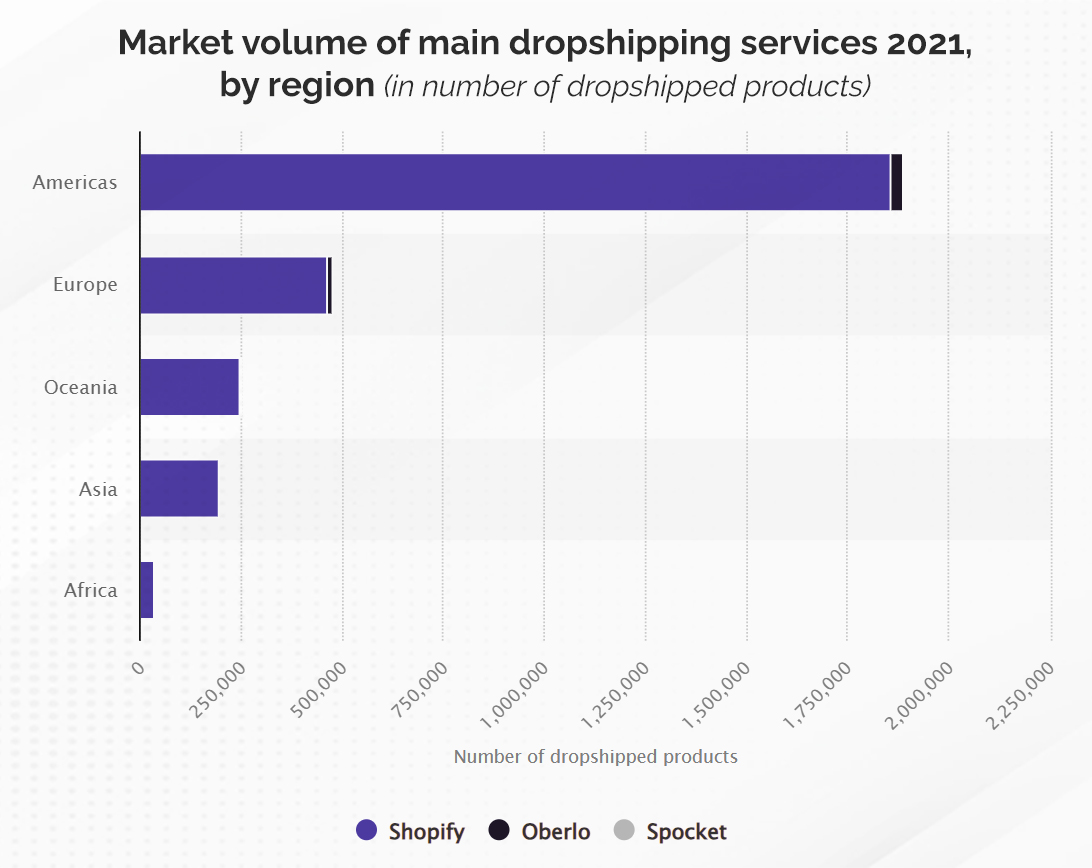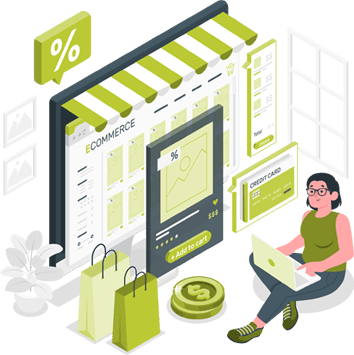
A Comprehensive Guide to Shopify Dropshipping
11 February 2025
Dropshipping has emerged as a reliable and popular eCommerce business model, and its revenue was worth £129 billion in 2021 in the UK alone. Shopify dropshipping is a go-to model for entrepreneurs and businesses alike.
The plethora of user-friendly tools, along with an intuitive interface, make Shopify the ideal eCommerce platform for dropshipping. A Shopify agency can help you build high-yielding online stores that ensure the smooth running of your dropshipping business.
There are three main online business platforms in the dropshipping business model: Shopify, Oberlo, and Spocket.
Shopify successfully beats the other two and has become a trusted choice for online merchants. The infographic below provides some insights of dropshipping market volume by region.

What is Shopify Dropshipping?
As the name suggests, this dropshipping business model is simply based on the Shopify ecommerce platform. So, if you want to sell products without having to manage stock, you can choose dropshipping on Shopify.
How does it work?
In this model, third parties are responsible for manufacturing, storing, packaging, and fulfilling orders that come to the online store. Online merchants can mainly focus on marketing and sales. When a customer places an order on the Shopify website, it is automatically directed to the dropshipping suppliers, who further takes care of order fulfilment and deliverables.
This helps streamline operations and achieve business objectives like high sales and revenue. The dropshipping business also equips the online store with various apps to extend functionalities.
How to Start Dropshipping on Shopify?
Step 1 – Perform Thorough Market Research
In building a dropshipping store, the foremost step is to analyse the market and the target audience. These are integral for the success of the eCommerce store. The important aspects to consider are:
- Who are the competitors?
- How can you offer something extra?
- What are your USPs?
- How will your dropshipping store stand out in the competitive market?
Step 2 – Focus on Building Brand Values
Unique store designs with easy-to-use interfaces help build credibility and drive sales. Choosing a Shopify Partner agency can help you build a professional website with theme customisation and the integration of appropriate colours, fonts, and graphics as per your brand values and appropriate to the business industry.
Step 3 – Create your Shopify Account & Store
It’s time to register and set up the Shopify account for building your online dropshipping business. You can do it yourself or a Shopify agency agency can take care of it. Ensure the dropshipping store is user-friendly and appealing to the customers.
Step 4 – Select your Dropshipping Supplier
You cannot run your dropshipping business without a dropshipping supplier. Thankfully, Shopify offers tons of options for choosing a suitable dropshipping supplier. You need to make a well-informed choice based on several factors that will drive your business to success.
Some of the important factors to consider for selecting your dropshipping supplier are:
- Begin by compiling a list of potential partners such as AliExpress or SaleHoo. You can also reach out to your industry contacts or niche directories for reaching viable partners.
- Global suppliers might appear tempting, but local suppliers can help you with faster shipping. Additionally, you can save on VAT with a local Shopify dropshipping supplier based in the UK.
- The attention to detail on the supplier’s products’ quality, shipping performance, and straightforward communication helps to build a growing business. Go through the company’s reviews and ratings from other shops.
- Order sample products and assess their quality first-hand before entering into any commitments with the store owners.
- Once you have identified a few potential partners, it’s time to have a thorough understanding of their pricing, payment terms, return policies, and shipping costs. Different suppliers follow different policies, based on which you can choose a suitable one for your needs. Remember, you need to set your online store policies that align with those of the dropshipping supplier.
Step 5 – Integrating Suppliers with Shopify
After partnering with reliable Shopify dropshipping suppliers, you need to ensure their seamless integration with the online store. This leads to smooth product listings, inventory level management, and on-time deliverables.
The process of integrating multiple suppliers with the dropshipping app store is as follows:
- You can use tools and dropshipping apps to seamlessly integrate suppliers with Shopify. The right tools can automate order management, product imports, etc.
- Logging into your Shopify account through the integration tool and granting standard permissions connects the Shopify store with the supplier.
- The next step is to browse the supplier’s catalogue and import products through the tool. Before importing products, you can tailor their titles, descriptions, and images to make them more SEO-friendly.
- Ensure that the tool synchronises the Shopify store with the supplier’s inventory. This will streamline inventory management.
Step 6 – Ensure an SEO-Friendly Store
As the Shopify dropshipping store owner, you are geared toward marketing and sales activities. It is necessary to ensure that the store is SEO-friendly and ranks well on search engine result pages. This helps to find potential customers and ensure optimum sales. Various marketing activities on social platforms and digital ads help to ensure greater visibility among customers.
Build a Dropshipping business on Shopify
Starting and running a Shopify dropshipping business may seem challenging as there’s stiff competition. However, a user-friendly store built by professionals helps to gain an edge in the market.
At chilliapple, an award-winning ecommerce agency, we can tailor SEO-friendly and easy-to-use stores that drive enhanced user experience (UX), sales, and revenue.





